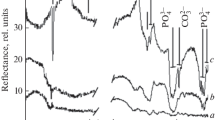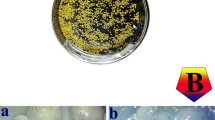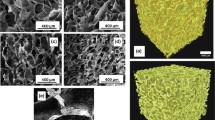Abstract
Alginate hydrogels are natural materials which can be used for biomedical purposes in order to trigger natural remineralization of damaged hard tissues. Mineralization of alginate hydrogels by using diverse protocols is extensively studied, with a goal of obtaining biocomposite materials having improved mechanical properties. The majority of the studies described in the literature are focused on the use of alginate in the form of beads, while alginate in bulk form has been more rarely studied. In this work, the influence of parameters, like phosphate concentration, type of media (water, HEPES and TRIS buffer) and pH (5.0, 7.4, 9.0), on gelation and mineralization of bulk alginate hydrogels (approx. 2 × 2 cm) was studied. Hydrogels were produced using semipermeable membranes. In all experiments, calcium chloride solution was added as a mineralizing solution to the alginate dissolved in medium containing disodium phosphate, which simultaneously triggered gelation and mineralization of hydrogels. Hydrogels were mineralized for 5 days with daily exchange of mineralizing solution. Such hydrogels were characterized using a combination of infrared spectroscopy, powder X-ray diffraction and electron microscopy. The obtained results demonstrated that the media and pH have a profound influence on gelation and the stability of the hydrogels. Octacalcium phosphate was formed in all hydrogels except in TRIS buffer at pH = 9.0 where amorphous calcium phosphate (ACP) was formed. ACP was stabilized during the experiments, as well as during the extraction from the hydrogel. The obtained results point to a protocol suitable for fine-tuning the properties of the mineralized hydrogel, by a simple change of experimental conditions.







Similar content being viewed by others
References
Crichton R (2019) Chapter 19 - Biomineralization. In: Crichton R (ed) Biological Inorganic Chemistry (Third Edition). Academic Press, pp 517–544
Lowenstam HA, Weiner S (1989) On biomineralization. Oxford University Press, New York
Mann S (2001) Biomineralization: principles and concepts in bioinorganic materials chemistry. Oxford University Press, New York
Li X, Deng Y, Wang M et al (2018) Stabilization of Ca-deficient hydroxyapatite in biphasic calcium phosphate ceramics by adding alginate to enhance their biological performances. J Mater Chem B 6:84–97. https://doi.org/10.1039/C7TB02620J
Jung SW, Byun J-H, Oh SH et al (2018) Multivalent ion-based in situ gelling polysaccharide hydrogel as an injectable bone graft. Carbohydr Polym 180:216–225. https://doi.org/10.1016/j.carbpol.2017.10.029
Xie M, Olderøy MØ, Andreassen J-P et al (2010) Alginate-controlled formation of nanoscale calcium carbonate and hydroxyapatite mineral phase within hydrogel networks. Acta Biomater 6:3665–3675. https://doi.org/10.1016/j.actbio.2010.03.034
Ma S, Yu B, Pei X, Zhou F (2016) Structural hydrogels. Polymer 98:516–535. https://doi.org/10.1016/j.polymer.2016.06.053
Hasirci N, Kilic C, Kömez A, et al (2016) Hydrogels in Regenerative Medicine. In: Gels Handbook,Fundamentals, Properties and ApplicationsVolume 2: Applications of Hydrogels in Regenerative Medicine, Edited by: Mohammad Reza Abidian, Umut Atakan Gurkan, Faramarz Edalat. WORLD SCIENTIFIC, pp 1–52
Zhao W, Jin X, Cong Y et al (2013) Degradable natural polymer hydrogels for articular cartilage tissue engineering. J Chem Technol Biotechnol 88:327–339. https://doi.org/10.1002/jctb.3970
Bai X, Gao M, Syed S et al (2018) Bioactive hydrogels for bone regeneration. Bioact Mater 3:401–417. https://doi.org/10.1016/j.bioactmat.2018.05.006
Nuttelman CR, Mortisen DJ, Henry SM, Anseth KS (2001) Attachment of fibronectin to poly(vinyl alcohol) hydrogels promotes NIH3T3 cell adhesion, proliferation, and migration. J Biomed Mater Res 57:217–223. https://doi.org/10.1002/1097-4636(200111)57:2<217::AID-JBM1161>3.0.CO;2-I
Nair LS, Laurencin CT (2007) Biodegradable polymers as biomaterials. Prog Polym Sci 32:762–798. https://doi.org/10.1016/j.progpolymsci.2007.05.017
Mihaila SM, Reis RL, Marques AP, Gomes ME (2016) Hydrogels in Bone Tissue Engineering: A Multi-Parametric Approach. In: Gels Handbook. WORLD SCIENTIFIC, pp 165–197
Kosanović C, Fermani S, Falini G, Kralj D (2017) Crystallization of Calcium Carbonate in Alginate and Xanthan Hydrogels. Crystals 7:355. https://doi.org/10.3390/cryst7120355
Ucar S, Bjørnøy SH, Bassett DC et al (2015) Nucleation and Growth of Brushite in the Presence of Alginate. Cryst Growth Des 15:5397–5405. https://doi.org/10.1021/acs.cgd.5b01032
Sancilio S, Gallorini M, Di Nisio C, et al (2018) Alginate/Hydroxyapatite-Based Nanocomposite Scaffolds for Bone Tissue Engineering Improve Dental Pulp Biomineralization and Differentiation. Stem Cells Int 2018, Article ID 9643721:13 pp. doi: https://doi.org/10.1155/2018/9643721
Bjørnøy SH, Bassett DC, Ucar S et al (2016) Controlled mineralisation and recrystallisation of brushite within alginate hydrogels. Biomed Mater 11:015013. https://doi.org/10.1088/1748-6041/11/1/015013
Dorozhkin SV (2012) Calcium Orthophosphates : Applications in Nature, Biology, and Medicine, 1st ed. Pan Stanford Publishing, New York, NY
Dorozhkin SV (2016) Multiphasic calcium orthophosphate (CaPO 4 ) bioceramics and their biomedical applications. Ceram Int 42:6529–6554. https://doi.org/10.1016/j.ceramint.2016.01.062
Yang N, Zhong Q, Zhou Y et al (2016) Controlled degradation pattern of hydroxyapatite/calcium carbonate composite microspheres: Controlled Degradation of Hydroxyapatite Microspheres. Microsc Res Tech 79:518–524. https://doi.org/10.1002/jemt.22661
Spiller KL, Maher SA, Lowman AM (2011) Hydrogels for the Repair of Articular Cartilage Defects. Tissue Eng Part B Rev 17:281–299. https://doi.org/10.1089/ten.teb.2011.0077
Cunniffe GM, Vinardell T, Thompson EM et al (2015) Chondrogenically primed mesenchymal stem cell-seeded alginate hydrogels promote early bone formation in critically-sized defects. Eur Polym J 72:464–472. https://doi.org/10.1016/j.eurpolymj.2015.07.021
Sawkins MJ, Bowen W, Dhadda P et al (2013) Hydrogels derived from demineralized and decellularized bone extracellular matrix. Acta Biomater 9:7865–7873. https://doi.org/10.1016/j.actbio.2013.04.029
Osmokrovic A, Jancic I, Vunduk J et al (2018) Achieving high antimicrobial activity: Composite alginate hydrogel beads releasing activated charcoal with an immobilized active agent. Carbohydr Polym 196:279–288. https://doi.org/10.1016/j.carbpol.2018.05.045
Abdalla K, Kamoun E, Maghraby G (2015) Optimization of the entrapment efficiency and release of ambroxol hydrochloride alginate beads. J Appl Pharm Sci 5:013–019. https://doi.org/10.7324/JAPS.2015.50403
Leslie SK, Nicolini AM, Sundaresan G et al (2016) Development of a cell delivery system using alginate microbeads for tissue regeneration. J Mater Chem B 4:3515–3525. https://doi.org/10.1039/C6TB00035E
Xie M, Olderøy MØ, Zhang Z et al (2012) Biocomposites prepared by alkaline phosphatase mediated mineralization of alginate microbeads. RSC Adv 2:1457–1465. https://doi.org/10.1039/C1RA00750E
Cholewinski A, Yang FK, Zhao B (2017) Underwater Contact Behavior of Alginate and Catechol-Conjugated Alginate Hydrogel Beads. Langmuir 33:8353–8361. https://doi.org/10.1021/acs.langmuir.7b00795
Bjørnøy SH, Bassett DC, Ucar S et al (2016) A correlative spatiotemporal microscale study of calcium phosphate formation and transformation within an alginate hydrogel matrix. Acta Biomater 44:254–266. https://doi.org/10.1016/j.actbio.2016.08.041
Bjørnøy SH, Mandaric S, Bassett DC et al (2016) Gelling kinetics and in situ mineralization of alginate hydrogels: A correlative spatiotemporal characterization toolbox. Acta Biomater 44:243–253. https://doi.org/10.1016/j.actbio.2016.07.046
Bajpai M, Shukla P, Bajpai SK (2017) Enhancement in the stability of alginate gels prepared with mixed solution of divalent ions using a diffusion through dialysis tube (DTDT) approach. J Macromol Sci Part A 54:301–310. https://doi.org/10.1080/10601325.2017.1294452
LeGeros RZ, Kijkowska R, LeGeros JP (1984) Formation and transformation of octacalcium phosphate, OCP: a preliminary report. Scan Electron Microsc Pt 4:1771–1777
Boanini E, Torricelli P, Gazzano M et al (2012) The effect of alendronate doped calcium phosphates on bone cells activity. Bone 51:944–952. https://doi.org/10.1016/j.bone.2012.07.020
Fuji T, Anada T, Honda Y et al (2009) Octacalcium Phosphate–Precipitated Alginate Scaffold for Bone Regeneration. Tissue Eng Part A 15:3525–3535. https://doi.org/10.1089/ten.tea.2009.0048
Zhao K, Cheng G, Huang J, Ying X (2008) Rebinding and recognition properties of protein-macromolecularly imprinted calcium phosphate/alginate hybrid polymer microspheres. React Funct Polym 68:732–741. https://doi.org/10.1016/j.reactfunctpolym.2007.11.011
Karampas IA, Kontoyannis CG (2013) Characterization of calcium phosphates mixtures. Vib Spectrosc 64:126–133. https://doi.org/10.1016/j.vibspec.2012.11.003
Koutsopoulos S (2002) Synthesis and characterization of hydroxyapatite crystals: a review study on the analytical methods. J Biomed Mater Res 62:600–612. https://doi.org/10.1002/jbm.10280
Drouet C (2013) Apatite Formation: Why It May Not Work as Planned, and How to Conclusively Identify Apatite Compounds. BioMed Res Int 013, Article ID 490946:12 pp. doi: https://doi.org/10.1155/2013/490946
Markovic M, Fowler BO, Brown WE (1993) Octacalcium phosphate carboxylates. 1. Preparation and identification. Chem Mater 5:1401–1405. https://doi.org/10.1021/cm00034a007
Ravichandran YD, Rajendiran R (2015) Development of a new carbon nanotube–alginate–hydroxyapatite tricomponent composite scaffold for application in bone tissue engineering. Int J Nanomedicine 10:7–15. https://doi.org/10.2147/IJN.S79971
Suzuki O (2010) Octacalcium phosphate: Osteoconductivity and crystal chemistry. Acta Biomater 6:3379–3387. https://doi.org/10.1016/j.actbio.2010.04.002
Iijima M, Moriwaki Y, Wen HB et al (2002) Elongated Growth of Octacalcium Phosphate Crystals in Recombinant Amelogenin Gels under Controlled Ionic Flow. J Dent Res 81:69–73. https://doi.org/10.1177/002203450208100115
Dabiri SMH, Lagazzo A, Barberis F et al (2016) Characterization of alginate-brushite in-situ hydrogel composites. Mater Sci Eng C 67:502–510. https://doi.org/10.1016/j.msec.2016.04.104
Amer W, Abdelouahdi K, Ramananarivo HR et al (2014) Smart designing of new hybrid materials based on brushite-alginate and monetite-alginate microspheres: Bio-inspired for sequential nucleation and growth. Mater Sci Eng C 35:341–346. https://doi.org/10.1016/j.msec.2013.11.012
Wang L, Nancollas GH (2009) Pathways to biomineralization and biodemineralization of calcium phosphates: the thermodynamic and kinetic controls. Dalton Trans 15:2665–2672. https://doi.org/10.1039/b815887h
Li S, Wang L (2012) Phosphorylated osteopontin peptides inhibit crystallization by resisting the aggregation of calcium phosphate nanoparticles. CrystEngComm 14:8037. https://doi.org/10.1039/c2ce26140e
Bar-Yosef Ofir P, Govrin-Lippman R, Garti N, Füredi-Milhofer H (2004) The Influence of Polyelectrolytes on the Formation and Phase Transformation of Amorphous Calcium Phosphate. Cryst Growth Des 4:177–183. https://doi.org/10.1021/cg034148g
Selmani A, Coha I, Magdić K et al (2015) Multiscale study of the influence of cationic surfactants on amorphous calcium phosphate precipitation. CrystEngComm 17:8529–8548. https://doi.org/10.1039/C5CE01516B
LeRoux MA, Guilak F, Setton LA (1999) Compressive and shear properties of alginate gel: Effects of sodium ions and alginate concentration. J Biomed Mater Res 47:46–53. https://doi.org/10.1002/(SICI)1097-4636(199910)47:1<46::AID-JBM6>3.0.CO;2-N
Eanes ED, Gillessen IH, Posner AS (1965) Intermediate States in the Precipitation of Hydroxyapatite. Nature 208:365. https://doi.org/10.1038/208365a0
Wang L, Nancollas GH (2008) Calcium Orthophosphates: Crystallization and Dissolution. Chem Rev 108:4628–4669. https://doi.org/10.1021/cr0782574
Brečević Lj, Füredi-Milhofer H (1972) Precipitation of calcium phosphates from electrolyte solutions: II. The formation and transformation of the precipitates. Calcif Tissue Res 10:82–90. https://doi.org/10.1007/BF02012538
Pan H, Liu XY, Tang R, Xu HY (2010) Mystery of the transformation from amorphous calcium phosphate to hydroxyapatite. Chem Commun 46:7415. https://doi.org/10.1039/c0cc00971g
Jiang S, Jin W, Wang Y-N et al (2017) Effect of the aggregation state of amorphous calcium phosphate on hydroxyapatite nucleation kinetics. RSC Adv 7:25497–25503. https://doi.org/10.1039/C7RA02208E
Despotović R, Filipović-Vinceković N, Füredi-Milhofer H (1975) Precipitation of calcium phosphates from electrolyte solutions. Calcif Tissue Res 18:13–26. https://doi.org/10.1007/BF02546223
Christoffersen J, Christoffersen MR, Kibalczyc W, Andersen FA (1989) A contribution to the understanding of the formation of calcium phosphates. J Cryst Growth 94:767–777. https://doi.org/10.1016/0022-0248(89)90102-4
Sikirić MD, Füredi-Milhofer H (2006) The influence of surface active molecules on the crystallization of biominerals in solution. Adv Colloid Interf Sci 128–130:135–158. https://doi.org/10.1016/j.cis.2006.11.022
Ding H, Pan H, Xu X, Tang R (2014) Toward a Detailed Understanding of Magnesium Ions on Hydroxyapatite Crystallization Inhibition. Cryst Growth Des 14:763–769. https://doi.org/10.1021/cg401619s
Chen Y, Gu W, Pan H et al (2014) Stabilizing amorphous calcium phosphate phase by citrate adsorption. CrystEngComm 16:1864–1867. https://doi.org/10.1039/C3CE42274G
Bleek K, Taubert A (2013) New developments in polymer-controlled, bioinspired calcium phosphate mineralization from aqueous solution. Acta Biomater 9:6283–6321. https://doi.org/10.1016/j.actbio.2012.12.027
Frayssinet P, Trouillet JL, Rouquet N et al (1993) Osseointegration of macroporous calcium phosphate ceramics having a different chemical composition. Biomaterials 14:423–429. https://doi.org/10.1016/0142-9612(93)90144-Q
Knaack D, Goad MEP, Aiolova M et al (1998) Resorbable calcium phosphate bone substitute. J Biomed Mater Res 43:399–409. https://doi.org/10.1002/(SICI)1097-4636(199824)43:4<399::AID-JBM7>3.3.CO;2-A
Kaunitz JD, Yamaguchi DT (2008) TNAP, TrAP, ecto-purinergic signaling, and bone remodeling. J Cell Biochem 105:655–662. https://doi.org/10.1002/jcb.21885
Bushinsky DA (1996) Metabolic alkalosis decreases bone calcium efflux by suppressing osteoclasts and stimulating osteoblasts. Am J Phys 271:F216–F222. https://doi.org/10.1152/ajprenal.1996.271.1.F216
Liu W, Wang T, Yang C et al (2016) Alkaline biodegradable implants for osteoporotic bone defects--importance of microenvironment pH. Osteoporos Int J Establ Result Coop Eur Found Osteoporos Natl Osteoporos Found USA 27:93–104. https://doi.org/10.1007/s00198-015-3217-8
Ito T, Saito M, Uchino T et al (2012) Preparation of injectable auto-forming alginate gel containing simvastatin with amorphous calcium phosphate as a controlled release medium and their therapeutic effect in osteoporosis model rat. J Mater Sci Mater Med 23:1291–1297. https://doi.org/10.1007/s10856-012-4597-3
Acknowledgements
Authors are grateful to Krunoslav Užarević for auxiliary PXRD measurements.
Funding
This research was funded by the Croatian Science Foundation under project HRZZ-IP-2013-11-5055.
Author information
Authors and Affiliations
Contributions
Conceptualization, Maja Dutour Sikirić; Funding acquisition, Damir Kralj; Investigation, Vida Strasser, Nives Matijaković, Daniel Mark Lyons, Tea Mihelj Josipović, Jasminka Kontrec and Damir Kralj; Methodology, Maja Dutour Sikirić; Writing – original draft, Maja Dutour Sikirić, Vida Strasser, Damir Kralj.
Corresponding author
Ethics declarations
Conflict of interest
The authors declare no conflict of interest.
Additional information
Publisher’s note
Springer Nature remains neutral with regard to jurisdictional claims in published maps and institutional affiliations.
Electronic supplementary material
ESM 1
(DOCX 2758 kb)
Rights and permissions
About this article
Cite this article
Strasser, V., Matijaković, N., Mihelj Josipović, T. et al. Factors affecting calcium phosphate mineralization within bulk alginate hydrogels. J Polym Res 26, 262 (2019). https://doi.org/10.1007/s10965-019-1942-y
Received:
Accepted:
Published:
DOI: https://doi.org/10.1007/s10965-019-1942-y




